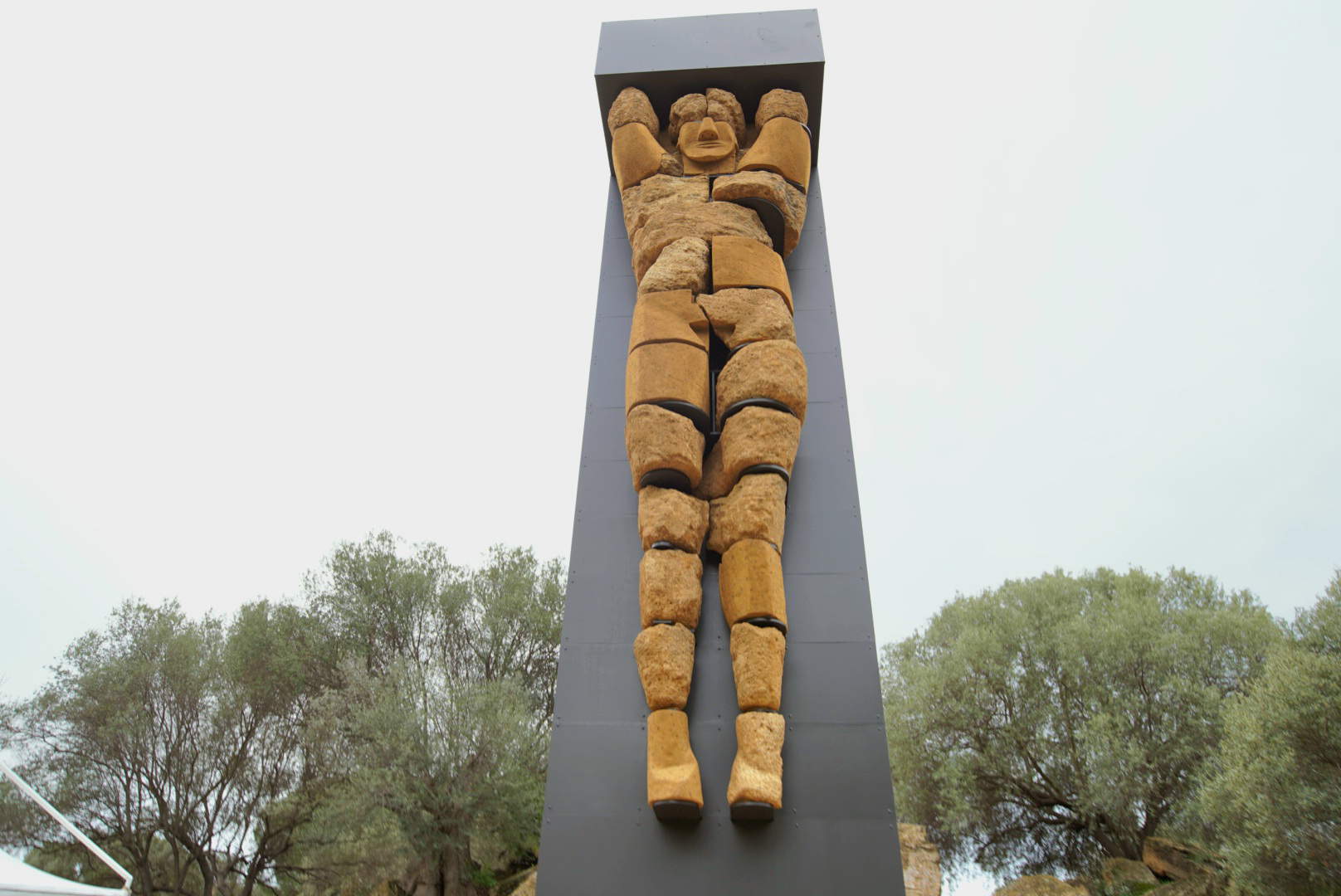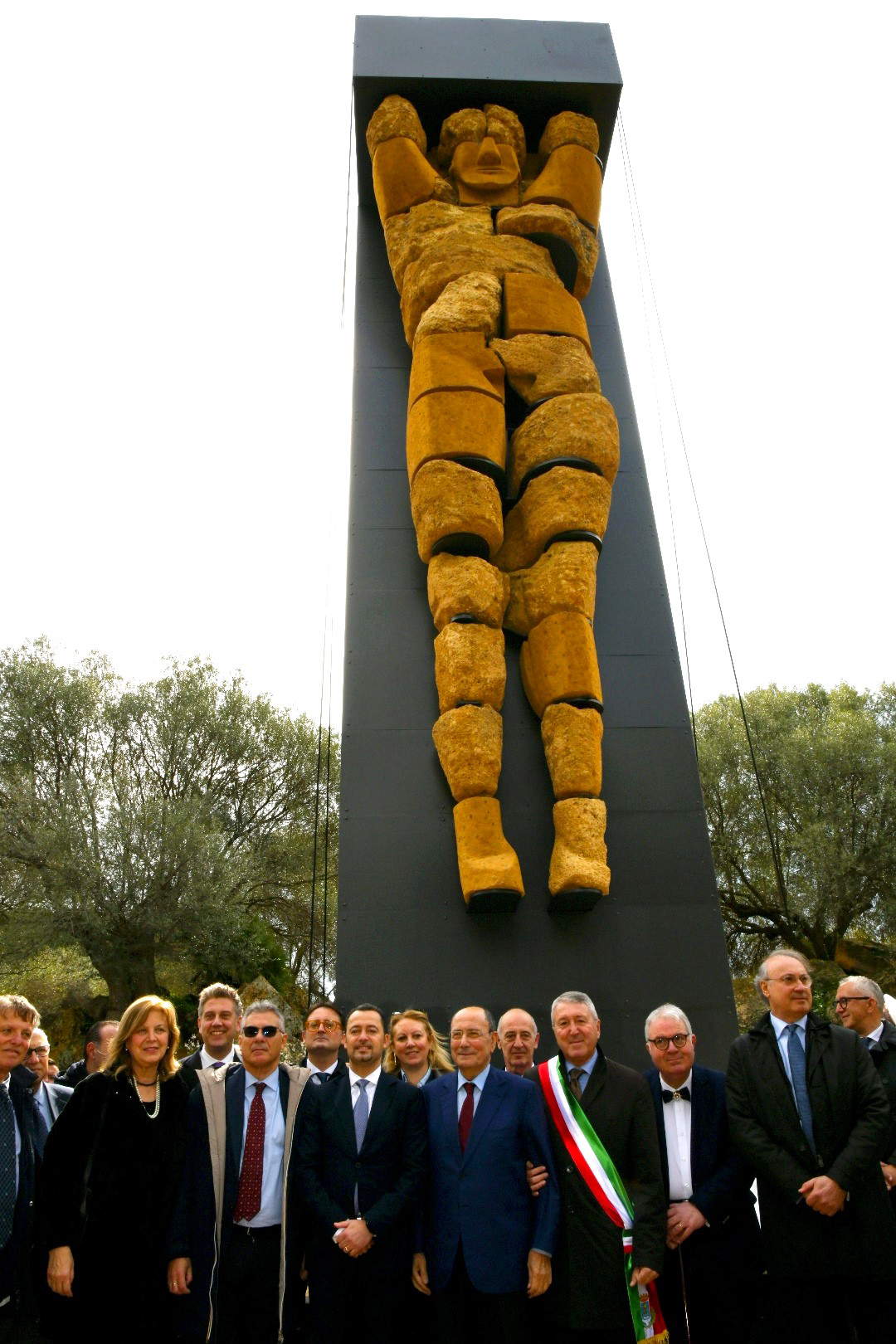Agrigento, raised the telamon of the temple of Zeus
In Agrigento, the stone colossus of ancient Akragas, or the "telamon," one of the titanic anthropomorphic figures that forcefully supported the lintel of the famous temple of Zeus Olympius (also known as the Olympieion, a tangible symbol of the magnificence of the Valley of the Temples), has returned to its upright position. This morning, a ceremony was held to unveil the telamon in the presence of dignitaries including the president of the Sicilian Region, Renato Schifani, the regional councillor for cultural heritage, Francesco Paolo Scarpinato, the director of the Archaeological and Landscape Park of the Valley of the Temples, Roberto Sciarratta, the mayor of Agrigento, Francesco Micciché, the prefect of Agrigento, Filippo Romano, the curator of the musealization project, Carmelo Bennardo, and the project’s scientific expert, Alessandro Carlino. This monumental statue, which towers nearly 8 meters (26 feet), is supported by a complex 12-meter-high steel structure, on which brackets have been anchored to house individual fragments of the monument, now brought together.
The extensive project to musealize the Olympieion area, financed so far with an investment of 500,000 euros from Park funds, includes an important future phase: the reconstruction on the ground of a significant portion of the temple’s entablature and cornice. This intervention aims not only to provide the public with a tangible idea of the colossal size and uniqueness of the monument, but also to ensure the preservation of the archaeological finds. This approach is intended to allow visitors to fully immerse themselves in the ancient grandeur of the Olympieion, offering a more immediate and engaging perspective of the temple’s majestic proportions. At the same time, this reconstruction is intended to act as a protective measure for the precious artifacts, preserving them for future generations.
In 2004, the Valley of the Temples Park initiated an extensive study and research campaign on the Olympieion, entrusting it to the Germanic Archaeological Institute in Rome, under the leadership of Heinz-Jürgen Beste. This challenging project not only helped expand our knowledge of this iconic monument, but also led to a thorough cataloging of the elements still present on the site. Through this work, more than 90 fragments were identified, belonging to at least eight distinct telamons. In particular, of one of them it was possible to preserve about two-thirds of the original elements that composed it. This homogeneous core of blocks became the focus of the reconstruction of the telamon, the “brother” of the one already restored at the end of the 19th century and currently on display at the “Pietro Griffo” Archaeological Museum. Leading this project is architect Carmelo Bennardo, curator and current director of the Archaeological Park of Syracuse, while ensuring the scientific validity of the operations is architect Alessandro Carlino.
The magnificent temple of Zeus Olympius, an imposing monument that testified to the grandeur and glory of the ancient city of Akragas, stood on the western part of the majestic Hill of Temples. Its construction dates back to the period following the city’s victory over the Carthaginians around 480 B.C., an event that marked a moment of triumph and was celebrated with the erection of this extraordinary structure in honor of the tyrant Theron. The temple of Zeus Olympius was distinguished by its bold architectural design, characterized by innovative and impressive solutions. Its extraordinarily tall fluted half-columns were so spacious that, according to Diodorus Siculus’ account, “a man could fit comfortably” in each of them. The dimensions of the temple itself were colossal, with a width of about 112 meters and a length of 56 meters, occupying an area of about 6,340 square meters (the Parthenon in Athens, to give a term of comparison, measures 69.54 by 30.87 meters). Constructed of local calcarenite blocks, this temple had an unusual plan, with seven Doric half-columns on each of the short sides and fourteen on each of the long sides. The structure of the building included an imposing lintel, consisting of three rows of blocks topped by a Doric frieze. Between the columns, at a height of about 11 meters, stood majestic monumental statues, the telamons, depicting human figures holding a heavy burden with their arms. Unfortunately, the majesty of the temple of Zeus Olympius was tragically interrupted by an earthquake in 1401, which irreparably compromised it. Later, in the 18th century, the temple was looted and plundered, with its precious blocks used for the construction of the pier at Porto Empedocle.
The Olympieion temple, along with the famous Temple of Concord and the fascinating temples of Paestum, exerted an irresistible appeal on travelers and scholars during the 18th and 19th centuries. In particular, its extraordinary impact on the father of modern art history, Johann Joachim Winckelmann, was remarkable: the great theorist of neoclassicism was stunned by the temple’s titanic dimensions, comparing its majestic columns to those of St. Peter’s Basilica.
The myth of the enigmatic Olympieion was also fueled by the engravings and watercolors of artists such as Jean Houel and Philipp Hackert, which helped create an aura of mystery around this majestic structure. Archaeologists of the time faced an enigma, wondering about its size and structure. However, it was a young British architect named Charles R. Cockerell, in 1812, who made a truly significant discovery: he first identified the existence of the telamons, recognizing a head that had been mistakenly attributed to the pediment during Bourbon excavations, and combining them to create an initial image of their appearance. Later, around 1920, Pirro Marconi unearthed several finds that are now part of the ongoing musealization project. It was then Superintendent Pietro Griffo, in 1965, who housed the first reconstructed telamon in the newly founded Archaeological Museum-now named after him.
In the following years, the growing interest in these enigmatic colossi, never mentioned in Diodorus’ original description of the temple, fueled a heated international debate among archaeologists, a debate that continues to this day.


Statements
“Today,” declared President Renato Schifani, “is an important day for Agrigento and for all of Sicily. It certifies the great attention of the regional government to the protection and enhancement of the immense artistic and cultural heritage that our island holds. The telamon, which today we deliver to the community in its extraordinary grandeur, represents one of the best business cards of Agrigento Capital of Culture. This stone giant of ancient Akragas, which after many years of study and research we can observe in its natural position, is the heart of an important project of musealization of the entire area of the temple of Zeus. However, today’s day should not be understood as a point of arrival, but should serve as a stimulus for all those involved to do more and better. We need to improve the attractiveness and enjoyment of our priceless cultural heritage. Although tourism figures for 2022 and 2023 tell us that Sicily is one of the most popular tourist destinations, the relationship between cultural heritage and tourist flows is still not, in my opinion, satisfactory. More and better can be done. We need to improve reception services, especially for people with disabilities, we need to increase the accommodation capacity towards foreign tourists, we need to work to make our jewels attractive 365 days a year, with a view to the process of deseasonalization of tourist flows.”
“The telamon,” says Regional Councillor for Cultural Heritage, Scarpinato, “will become one of the points of attraction of the Valley of the Temples, a new international ambassador of a unique archaeological site that, just last November, exceeded one million visitors in one year. Thanks to an enhancement project that includes guided tours, an augmented reality project and even special lighting to encourage nighttime visits, we will be able to introduce this impressive work to the international community.”
“The work we have conducted on the telamon and the entire area of the Olympeion,” stresses Roberto Sciarratta, director of the Valley of the Temples Park, “perfectly fulfills our mission of protecting and enhancing the Valley of the Temples, along with identifying, preserving, studying, researching and promoting any intervention that brings the development of resources of the territory. Since 2019, since I have been at the helm of the Park, I have made the project of the previous director Pietro Meli my own, but I have also responded to the great fascination exercised by these stone giants, from ancient times to the present.”
 |
| Agrigento, raised the telamon of the temple of Zeus |
Warning: the translation into English of the original Italian article was created using automatic tools. We undertake to review all articles, but we do not guarantee the total absence of inaccuracies in the translation due to the program. You can find the original by clicking on the ITA button. If you find any mistake,please contact us.



























